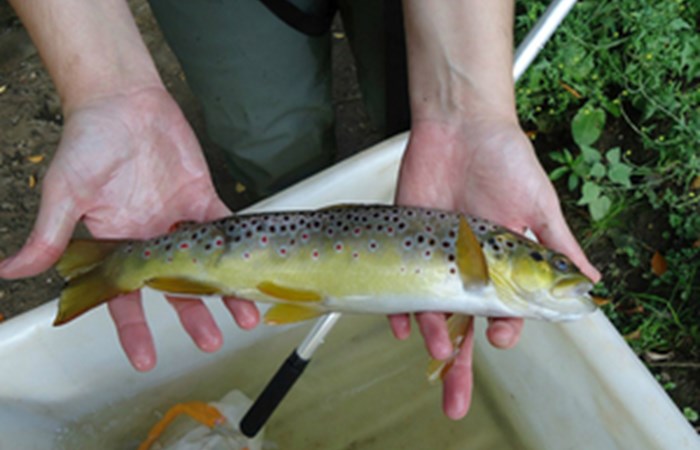Environment Agency

This follows successful work to improve the ecology and habitat of the brook.
The Lyme Brook runs through the heart of the town, and has suffered from poor water quality from as far back as the industrial revolution when new industry and development had an impact on the brook.
Since the 1980s water quality in the Lyme Brook, one of a number of brooks that form the headwaters of the iconic River Trent, has dramatically improved. In recent years, using the Environment Agencys Environment Improvement Fund, a partnership called the Staffordshire Trent Valley Catchment Partnership has been working to improve the habitat of the brook, mainly through Lyme Valley Parkway.
This volunteer-led programme that brings together Groundwork West Midlands, the Wild Trout Trust, Newcastle-under-Lyme Borough Council, Staffordshire Wildlife Trust and the National Citizen Service has been making all sorts of improvements to encourage brown trout to return to their ancient spawning grounds. And the partnership is excited to say, brown trout have been found.
Stephen Cook from Groundwork West Midlands said:
Its great to see that the years of hard work by local people have paid off.
The fact trout are in the brook means that other species will be thriving too and the quality of the habitat must be improving which is so important. It was also great fun creating the new berms, shifting the gravel and teaching children about their waterways so this news is just the icing on the cake.
Councillor Ann Beech, Newcastle-under-Lyme Borough Council cabinet member for operational services, added:
The Borough Council is proud to be involved in a partnership project which is already reaping the rewards of work to improve the water environment at the Lyme Brook.
Its great news that brown trout have returned its a clear indicator of the brooks renewed health as high quality water and a good habitat are vital requirements for them to spawn. Where they thrive, other wildlife will too.
Although the Environment Agency has found brown trout, the work doesnt stop. The partnership is continuing to work on further habitat improvements so the brook can sustain trout breeding populations.
It is currently looking to recruit members for a Friends of the Lyme Brook group to safeguard this work and lead on future improvements. If you are interested, please call Groundwork on 01782 829914 or email Stephen.cook@groundwork.org.uk.
Mel Westlake, Catchment Coordinator from Staffordshire Trent Valley Catchment said:
This is fantastic news as brown trout are an indicator that the work being carried out by the Staffordshire Trent Valley Catchment partners is having a real and lasting effect on the water quality and habitats for fish.
The brown trout is synonymous with Newcastle-under-Lyme for a number of reasons including appearing on the boroughs coat of arms as well as featuring on the statue on the roundabout in the centre of the town.
We hope to be able to continue with more of this restoration work throughout the whole of the Trent Catchment ensuring that brown trout are once again a common site in our local rivers and brooks.
Hopefully in the near future, brown trout will again be a common sight in Newcastle.
Background
The trout were found on an Environment Agency fish survey of the brook. The trout were measured and returned unharmed to the water.
Improvements led by Groundwork West Midlands were carried out through a series of volunteer-centred events using volunteers from the local community, Friends of Lyme Valley Parkway, Environment Agency and National Citizen Service.
These improvements have involved the creation of shallow sloping berms along the bank side using brushwood from the pollarding and coppicing of suitable trees nearby. Opposite each berm, sections of the bank side have been removed with a mini-digger allowing the brook to wiggle.
In addition, gravel spawning areas (riffles) have been created by placing gravel at locations in the brook, together with pinned woody debris, which has been fixed into the banks. Woody material becomes home to invertebrates and is a good hiding place for young fish.
Yellow flag iris and sedge have been planted along this section of the bank and in the muddy pockets within the berms. These plants will provide shelter and shade for developing fish and for adult fish. Further details of the project are online and there are films showing the making of the Lyme Brook wiggle.
